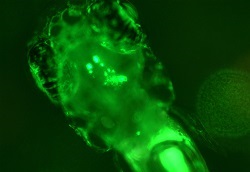Molecular crosstalk during heart development
Calcium ions (Ca2+) play an instrumental role in cardiac biology – from excitation-contraction coupling to the regulation of hormone secretion and gene expression. Elucidating the interplay between major signalling pathways and electrochemical cues during embryogenesis is paramount for understanding normal and pathological heart development. The EU-funded WNT/CALCIUM IN HEART project focused on the major morphogenetic Wnt signalling pathway and the crosstalk with Ca2+ signalling during development. Previous work had shown that Wnt11 non-canonical signalling patterns intercellular electrical coupling in the myocardial epithelium through transmembrane Ca2+ conductance. The work of WNT/CALCIUM IN HEART focused on the fundamental molecular mechanisms that govern the attenuation of L-type Ca2+ channel (LTCC) function by Wnt11 in excitable as well as non-excitable tissues. To investigate how Wnt11 regulates LTCC at subcellular resolution, researchers employed cell-based assays and performed immunological and biochemical experiments. Results showed that Wnt11 does not alter the LTCC at the transcriptional level, nor its localisation or abundance. Wnt11 signalling was found to prevent LTCC phosphorylation and regulate conductance by protein kinase A through a novel A-kinase anchoring protein. Similar work was performed in endothelial cells to determine calcium fluxes in non-excitable cells. Scientists discovered that Ca2+ fluxes through the LTCC are implicated in modulating endothelial cell motility. Furthermore, the distinct inter and intracellular calcium concentrations are crucial for proper angiogenesis. Taken together, the findings of the project illustrate that the molecules that control the cellular events underlying cardiac morphogenesis also regulate the extent of intercellular electrical coupling, actively contributing to the patterning of heart function. This further underscores the association between organ form and function, and unveils important developmental processes that lead to proper tissue formation. From a clinical perspective, this knowledge can serve as the basis for comprehending the pathophysiology of common cardiovascular diseases.







